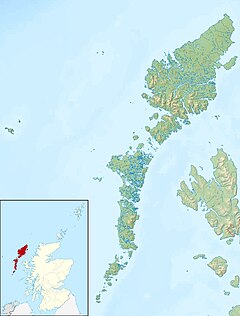Flannan Isles Lighthouse

The lighthouse on Eilean Mòr. The Chapel of St Flannan can be seen on the slope to the right of the lighthouse.
|
|
|
Outer Hebrides
|
|
| Location | Eilean Mòr 32 kilometres (20 mi) west of Lewis Western Isles Scotland |
|---|---|
| Coordinates | 58°17′17″N 7°35′16″W / 58.2881°N 7.5879°WCoordinates: 58°17′17″N 7°35′16″W / 58.2881°N 7.5879°W |
| Year first constructed | 1899 |
| Automated | 1971 |
| Construction | masonry tower |
| Tower shape | cylindrical tower with balcony and lantern attached to 1-storey keeper's house |
| Markings / pattern | white tower, black lantern, ochre trim |
| Height | 23 metres (75 ft) |
| Focal height | 101 metres (331 ft) |
| Current lens | 3rd order clamshell Fresnel lens |
| Light source | solar power |
| Range | 20 nautical miles (37 km; 23 mi) |
| Characteristic | Fl (2) W 30s. |
| Admiralty number | A4028 |
| NGA number | 3912 |
| ARLHS number | SCO-084 |
| Managing agent |
Northern Lighthouse Board |
Northern Lighthouse Board
Flannan Isles Lighthouse is a lighthouse near the highest point on Eilean Mòr, one of the Flannan Isles in the Outer Hebrides off the west coast of Scotland. It is best known for the mysterious disappearance of its keepers in 1900.
The 23-metre (75 ft) lighthouse was designed by David Alan Stevenson for the Northern Lighthouse Board (NLB). Construction, between 1895 and 1899, was undertaken by George Lawson of Rutherglen at a cost of £6,914 inclusive of the building of the landing places, stairs, railway tracks etc. All of the materials used had to be hauled up the 45-metre (148 ft) cliffs directly from supply boats, no trivial task in the ever-churning Atlantic. A further £3,526 was spent on the shore station at Breasclete on the Isle of Lewis. It was first lit on 7 December 1899.
The purpose of the railway tracks was to facilitate the transport of provisions for the keepers and fuel for the light (paraffin, at that date; the light consumed twenty barrels a year) up the steep gradients from the landing places by means of a cable-hauled railway. This was powered by a small steam engine in a shed adjoining the lighthouse. A track descended from the lighthouse in a westerly direction and then curved round to the south. In the approximate centre of the island it forked by means of a set of hand-operated points humorously dubbed "Clapham Junction"; one branch continued in its curvature to head eastwards to the east landing place, on the south-east corner of the island, thus forming a half-circle, while the other, slightly shorter, branch curved back to the west to serve the west landing, situated in a small inlet on the island's south coast. The final approaches to the landing stages were extremely steep. The cable was guided round the curves by pulleys set between the rails, and a line of posts set outside the inner rail prevented it from going too far astray should it jump off the pulleys. The cargo was carried in a small four-wheeled bogie.
In 1925, the lighthouse was one of the first Scottish lights to receive communications from the shore by wireless telegraphy. In the 1960s, the island's transport system was modernised. The railway was removed, leaving behind the concrete bed on which it had been laid to serve as a roadway for a "Gnat" – a three-wheeled, rubber-tyred cross-country vehicle powered by a 400cc four-stroke engine, built by Aimers McLean of Galashiels. This had a somewhat shorter working life than the railway, becoming redundant in its turn when the helipad was constructed.
...
Wikipedia

